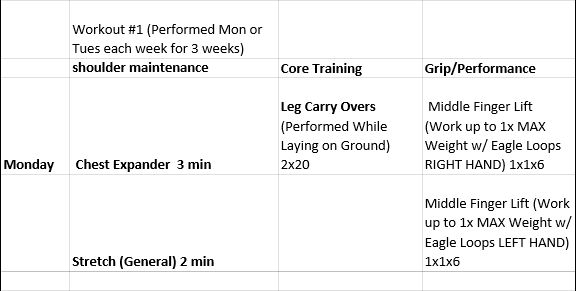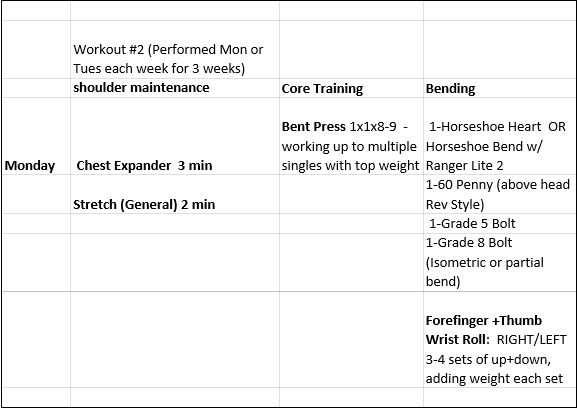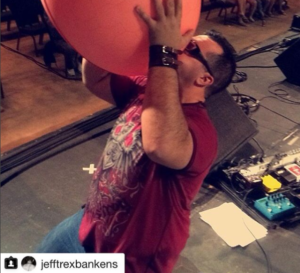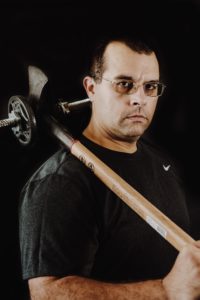Jeff “TRex” Bankens: From 4H to Performing Strongman
Strongman wasn’t invented by ESPN. The original strongman was a traveling performer, who wowed crowds with incredible feats night after night. Jeff “TRex” Bankens is a performing strongman who carries on that legacy as he goes from place to place sharing the Gospel message while blowing up hot water bottles, bending steel nails and snapping baseball bats.
Personal Bests and World Records
Bent Press
Right now my best in the bent press is 140 pounds, but I actually have a set of wagon wheels that was turned into barbell plates with a matching short two inch axle that I was given by someone. that were actually owned at one time or given to him by the wrestler Mark Henry. I don’t have the letter proving that yet but my goal is to one day be able to bent press those.
Trap Bar Deadlift
I was able to work up to a set of 20 with 300 pounds and I have started over again. I’m now in my third week of 20 reps trap bar dead lifts and my goal this time is to work up to 325 for 20.My goal one day is to get like 400 for 20.
World Records
These are all very impressive; but why Record Holders Republic and not the better known Guinness Book?
They are genuine & take world records seriously, they are economic, they are run and adjudicated by other record holders & entertainers. Dr. David Adamovich “The Great Throwdini” presides over the RHR American branch and they are easy to work with.
Car Pulling
2 autos (total weight 9,530 lbs. including 2 passengers): pulled 25 feet using a neck harness: 26 seconds.” I did this on live TV in my hometown about 4-5 years ago, in our local McDonald’s parking lot. I am sad to say their server crashed, so I no longer have a video of this one, but it was a blast!
Chain Breaking
- #12 Jack Chain: 3 at once: 0.5 second.
- #12 Jack Chain: 20 (10 sets of 2): 1 min.
- #12 Jack Chain: 4 at one time.
- I was able to break #6 jack chain, which is the biggest chain strongmen break, with one finger.
Finger Lifting
195 lbs.: 1 Finger: 1 Minute: 6. Inserting his middle finger into a finger ring, Jeff “TRex” Bankens lifted a 195 lb. male a height of 6 inches for a minimum of 1 second/lift. October 2017. This was performed in the middle of a shaky wrestling ring (it moved every time I lifted) in front of a live audience in October, 2017.
 What are some of your most memorable performances?
What are some of your most memorable performances?
I had the privilege and honor, this year, of doing a four-night children’s revival. It was not at my own church, it was actually at Grace Baptist, a large church in our area. Two of those days we went to schools, every night we did a different performance, which also included a different message. We probably got to minister and perform for thousands of kids. It was stretched over a four night period and a two day period.
You currently hold five World Records with Record Holders Republic for your feats of neck strength. You said that growing up you weren’t very athletic but you did have to be strong because of being involved in livestock shows. Did you have to lift the animals?
Being strong did help with that; stacking hay and fooling with animals. You know you gotta have strength for that because if you’re weak they’re not going to pay much attention to you when you’re trying to get a hold of them.
So if you’re not strong enough to make them pay attention to you then you’ll just get run over?
Pretty much.
Strong Mind in a Strong Body
When I interviewed Bud Jeffries he mentioned that as a performing strongman you need to be able to summon maximal strength without psyching yourself up like a powerlifter to avoid adrenal fatigue. What’s your favorite way to prepare for a strength demonstration feat?
When you’re practicing, which is training, there’s no audience before you. There’s no big adrenaline rush because you’ve might have had a rough day at the office. I think those conditions without all the frills, without all the loud music, the clapping, the yelling, and all the other things the audience tends to do, makes it a lot tougher to perform.
So, actually, you should be able to, in a maximal sense, bend thicker steel bars than you perform on stage, or bend heavier horseshoes, or tear more decks of cards or more phone books, or whatever the case may be.
It’s kind of what Brandon Lilly called your everyday strength—
Yeah, your feats need to be everyday strength. That’s exactly right.
You said, “You don’t become strong overnight. It takes a process of diligence, time and patience in training.” This is so counter to what we see in mainstream fitness culture! What other falsehoods do you think people embarking on a training program have to get past to start making real progress?
One of things is you don’t have to train so often. At least, not in the sense that the muscle magazines would have you do. The guys that take the photo shoots are on steroids a lot of the times and they’re edited with Photoshop and air-brushed, or whatever they do. On top of that, now we know from certain people on Instagram and Facebook, that some of them use fake weights.

What I’ve learned over the years now is I don’t train real often, maybe four to five times a week including my cardio days. I get more out of that now than I ever did out of all those years of struggle and drudgery trying to go to the gym all the time.
I’ve written that too many people tend to compartmentalize their lives, physical training is separated from spiritual training. They have their gym time, their work time, and assuming that they go to church, they have their church time. I like that you use your training sessions as part of your devotional time. It’s really a way to make your training an act of worship.
The idea came to me, and I believe it was from the Holy Spirit, just say a little prayer before your workout. It’s just a simple prayer. “God bless this workout and help us to grow in our mind, our body, our spirit and help us to be safe.” From that little first prayer, later on, I knew I needed to keep track of things so I started keeping a log. That also led to the thought that popped in my mind— I just felt like God was telling me that, one day, he would use my strength to help other people.
Training Philosophy
Jeff you said that you think odd object lifting should not be the mainstay of a training program. You believe that the bulk of a program should be centered around barbells and dumbbells. This fits with the principle of building strength not testing strength in every session. Can you elaborate on that?
What I discovered was, just in odd object lifting, I really was not growing in strength. I was getting injured and it’s because I was trying to lift as heavy of an odd object at each workout as I could rather than keeping my body going with the regular barbell and dumbbell standards of full-body lifting.
It’s just a nice accessory. A nice way to test yourself and a nice change of pace. The barbells and dumbbells is what gets you where you need to be.
With the help of Bob Whelan, my strength has gone up tremendously. It’s all because I had to swallow my pride and start over. I only did that because God put some good men in my life that were willing to tell me that instead of saying, “oh, you just keep doing that you’re gonna get stronger.”

You do believe that odd objects make for great finishers. Do you use that as another form of cardio?
Sometimes I’ll do some keg lifting, do some keg tossing, rock lifting as a finisher. I have an O2 trainer by Bas Rutten, the former MMA fighter I use while I’m mowing the grass in the summer time. That’s actually a pretty good cardio workout!
Talk about the benefits of cardio for strength athletes and how you structure your training to avoid losing strength gains.
losing strength gains.
I’m a big guy, but implementing the two to three days of cardio a week, on a regular basis the last two years has helped me tremendously.
I perform better when I do my performances for the strength shows or the churches that I speak at. When I teach Sunday school to the fourth or fifth graders, I don’t get winded. I can talk the whole hour and not run out of wind. I have no problem walking the quarter or half mile from my car to where I work at, at the refinery I work in.
You like the thick handled wrist roller, but you use a different method than most people. You prefer rolling with only the four fingers of one hand at a time. Do you use a rack mounted wrist roller?
Yeah, actually, it’s the Iron Mind One Wicked Wrist Roller™. You don’t have to use that one. The center of it is hollow and covered in some type or rubber or plastic. The reason it’s hollow is so that you can put it on one of the pins of your power rack.
When I use one hand at a time I’m pretty much mimicking the movement of rolling up a frying pan. I use whichever hand I’m not working as my brake so [I don’t drop the weight on myself]. Sometimes you get up to some pretty heavy weights.
Moving away from grip, lets talk about something that I first saw Franco Columbu do on pumping iron. Watching you burst a hot water bottle is impressive. It looks like hat takes a ton of core strength to keep the air pressure on the bottle.
If you’re gonna burst hot water bottles, you gotta be ready for the pain in your lungs from having to hold that pressure. When you look at a hot water bottle, you’ve got the cap that keeps it closed when you fill it with water. Above that is the big rubber lip that forms a big ridge around the cap where you screw it in. What I noticed was that people were just using that to hold it to their mouth. That was taking too much energy on my arms, my chest, my shoulders. So I blow it up to the size of a basketball, put my hands on the bottom of it, and just pull it to my mouth and it saves me a lot of energy. I can walk around and blow ’em up and not ever get tired doing it, unless it’s one of the bigger hot water bottles.
There’s one that takes about 28 to 30 hard breaths. You have got to put everything you have into it before it pops.
What surprised you the most about that feat when you started learning how to do it?
Believe it or not, I’ve probably done a few hundred water bottles over the years. Every time it gets big I still get a little nervous when it’s getting ready to pop. They put out a tremendous amount of force. One time, I guess I tore some ligaments or something in one of my fingers when the bottle burst.
How long did it take for you to be able to work your grip again?
It wasn’t too bad. My finger just looked funny. It scared me. I’d never had that happen before. It was one of the top ligaments on the top of the finger so I didn’t really hurt my grip strength too much.
You’re a pretty flexible guy! Your combo feat where you rip a phonebook in three pieces then bend a 60 penny nail while in a Wrestler’s Bridge showed that you’re not only mobile enough to get in and out of the position pretty easily but also that you’re comfortable enough in that position to display strength from there.
I bend a wrench that way also; a six inch crescent wrench.
What do you do to maintain your mobility?
I stretch before I workout, get massage therapy on a regular basis. Chiropractic work. I use the chest expanders to work on the mobility of my back and my chest.
Bent Press enthusiast John Flower has said “based on a letter from Kurt Saxon talking about how they trained” the Saxon brothers preferred, “Six days a week 30 reps each day of Bent Press plus evening shows and Two Hands Anyhow”. You’re an advocate of “2 full body workouts plus 2 (or 3) cardio days, per week”. Why two days a week as opposed to some of the more frequent training?
I believe part of that is he’s not working with a maximum load every workout. He’s just getting his body used to doing the bent press over and over. There’s no rule against six days a week or two days a week. You need to find out what works best, not only for you but for your family and your lifestyle. Also, if had to do it six days a week, I would look at it more as another job. It wouldn’t be as fun for me.
You said that you do cardio/abs/neck/forearms/hand strengthening on non-lifting nights. How do you keep your grip work from impacting your lifting?
That goes back to what you asked me earlier, how do you get your body used to being able to do this over and over and over? It’s from training over and over and over and getting yourself used to it.
I knock out 100 reps of the gripper on each hand each day between the drive from my home to my work. Sometimes I may have to take it into my office for a few minutes. I also knock out 100 reps with each hand with these rubber bands used to work the extensors of your fingers so that you work both your opposing muscles of your hands.
Doing that, along with my regular workout, has increased my grip. I may tax my grip, but, in a shorter time it recovers now because I’m making it work. The blood flow and everything else I’m doing, keeps my hands in good shape. It’s gonna make them not be arthritic, I guess, when I get older, for doing all this crazy stuff.
Passing it On
You talk about how being strong helped you with farm work. In this day and age so many people have sedentary jobs. How can normal people use your training methods in their training and what are the benefits to them of including that type of training even if they don’t plan to be performing strongmen?
Sometimes you’re gonna have some odd jobs to do and if you’re prepared by doing the type of workouts that I do, then it won’t tax you.
One of the best workouts you’ll do is doing steel scrolling. There are people that actually make extra money by making scrolled steel art and making it all by hand by bending it. If you have some artistic leaning people out there, they may want to get into that just for the heck of it. Last time I trained with Dennis Rogers, he was able to tutor me into making a wine bottle holder, if you can believe that.
Dennis Rogers, as far as I’m concerned, is the man. My wife and I saw him at the Arnold. He came out after the pro strongmen had just done two competitions. He mentioned that he also did feats of strength, so the crowd is like, “Okay. We knew he had to be strong or he wouldn’t be on the stage, but it wasn’t until I saw him snap a crescent wrench— that’s not regular strong, that’s STRONG! Everyone was paying attention after he snapped that.
So, you mentioned that Dinosaur Training by Brooks Kubik changed your life and helped get you back on track with solid training principles. What other training manuals do you recommend?
- Iron Nation by Bob Whalen it’s a compilation of different strength authors with mostly different styles of training.
- Strength, Muscle, and Power by Brooks Kubik.
- Supernatural Strength by Bob Whalen. (A compilation of his articles that he wrote for Stuart McRoberts Hardgainer)
- Goerner the Mighty by Edgar Mueller. Really inspirational and it gives some ideas if you’re wanting to be a performance strongman
- Keys to Progress – John McCallum
Yeah, John McCallum, he’s one of my inspirations. He and Paul Kelso. If I ever am able to write like those guys, I’ll think I’ve finally done something. I actually have a copy of Keys to Progress on my bookshelf at home.
I’ll tell ya another one that you might want to read, just for inspiration, Spiritual Journey of Joseph L. Greenstein
The Mighty Atom!
The Mighty Atom. His book is alive for me! I’d heard of Dennis Rogers for years. I’ve talked about him some in this interview, but the reason I met him was they were looking for performing strongmen to interview.They flew me to interview me for this Mighty Atom movie and the problem was, I didn’t know a whole lot about the Mighty Atom, but I still go to go on the trip. This was a couple years ago.
I got to meet Dennis Rogers and Slim “the Hammer Man” in person. Shortly thereafter I go to start being mentored by Dennis. He was like, “You need to come to one of my workshops, Man, I’m telling ya it’ll change your training and everything!” He was right and now we’re friends because of that.
You mentioned that you learned a lot from DVDs at home. What are your favorite training DVDs to recommend to a beginner who’s interested in what you do?
Dennis Rogers has some good books and DVDs out there.
 Let’s say someone wanted to get into strongman feats, either to become a performing strongman or just because they find it interesting, how would they do it?
Let’s say someone wanted to get into strongman feats, either to become a performing strongman or just because they find it interesting, how would they do it?
While I do not consider myself an expert, I do have a lot of experience. Your readers can feel free to contact me regarding training information, techniques, etc. I am more than glad to provide help or guidance as best as I can. I can also point them in the right direction in regards to locating the right experts to train with.
My experience shows that the best teaching comes from small group or one-on-one training. This includes weight training & specifically how to perform feats of strength. I recommend utilizing the following men as coaches & mentors. They sell products that can definitely help you grow as a lifter & strongman. Products may include live or online coaching, video / DVD’s, books, etc. In my educated opinion, hands on training is the best, so save up for the cost of a workshop or one-on-one training time and utilize their other products until you are able to save enough money to meet in person.
Bob Whelan – One of the top Strength Coaches in the USA
Dennis Rogers – Grandmaster Strongman / Mentor & Coach to many of the top performing strongmen of our day
Dave Whitley – Performing Strongman, Gym Owner, Kettlebell Instructor & Leader of Oldetime Strongman University Workshops –
Adam T. Glass – Performing Strongman, Grip Specialist, & Coach
Bud Jeffries – Performing Strongman & Physical Culturist
How can people get in touch with you if they want to book you for a performance or if they want to simply follow your training?
Phone: 337-884-5406
Website: http://www.jefftrexbankens.com/
Youtube: https://www.youtube.com/user/MrJbanken01
Facebook: https://www.facebook.com/Jefftrexbankenscom-157752864261395/
Twitter: https://twitter.com/TRex4JC

